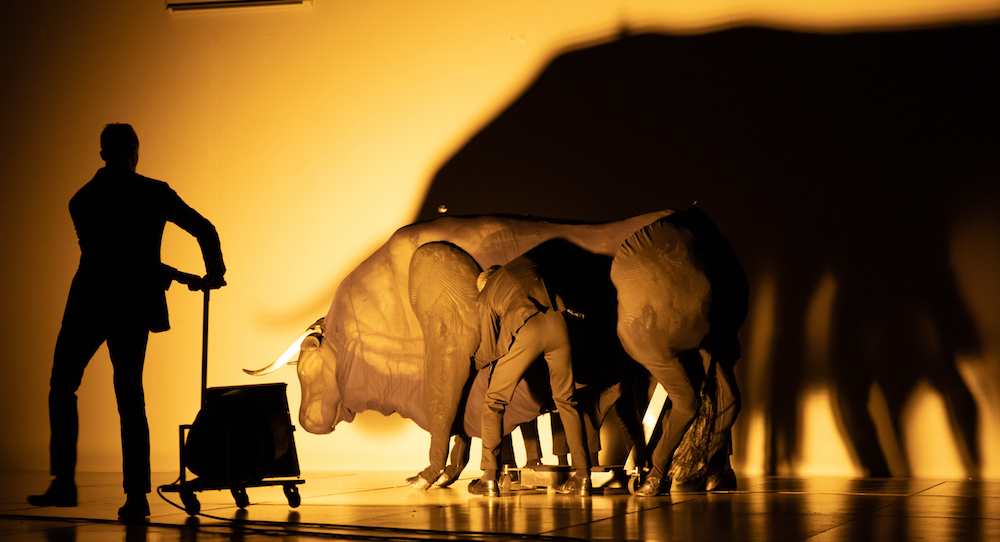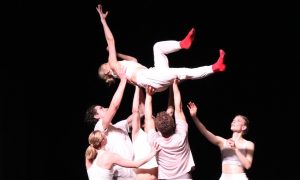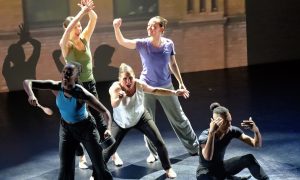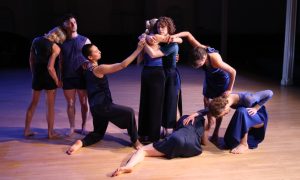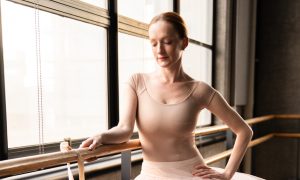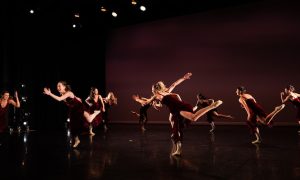Brooklyn Academy of Music, Brooklyn, NY.
November 8, 2022.
The set of Transverse Orientation, Dimitris Papaioannou’s latest work, is simple: a white wall with a white door and a flickering fluorescent. Suited men with bobbling black balloons for heads enter through the door carrying ladders, fascinated like moths by the shuddering tube of light. They approach it magnetically, try clumsily to eliminate the flicker –– the first iteration of one of the piece’s primary motifs. Their awkward sidelong gait and farcical antics delight the audience even as we cringe when they walk nonchalantly beneath a ladder, perhaps a lighthearted omen of what’s to come. Because their coats cover their heads and the balloons float above, the dancers look huge –– a jab at the grandiosity of “serious men” whose heads are really just filled with air? The opening scene ends with an opposing illusion; one dancer appears child-sized. He bangs his “head” against the wall over and over again (a task which is later repeated by another “character”) before being pulled into the darkness of whatever lies behind the set door.
Vivaldi string music comes in, convulsing as an extraordinarily realistic bull is wheeled onto the stage. A man and the bull face off as intense bass-heavy droning shakes the theater. The dancers puppeteering the bull rise to the challenge of manipulating it while making it seem like it’s manipulating them, and possible themes spin through my mind. The Charging Bull of Wall Street? Man versus money? Or perhaps more deeply, man (hiding behind money) versus man.
The man and the bull seem to befriend each other, if only temporarily, and at peace, the bull drinks from a bucket, the role of its tongue played by the supple hand of a dancer standing behind. Before we know it, half the cast is undressed and a nude woman is birthed from the bull’s stomach.
She folds herself into the frame of a cot, following up her tangled, orgiastic movement with a deadpan look at the crowd that elicits audible laughter. (The bull intermittently lapping water from the bucket in the background is a genius touch.) This solo is later repeated by a male dancer in female dress (finally the distinctly non-heteronormative moment we’ve been waiting for!), its repetition in a new context more grotesque than funny. Suited voyeurs watch from behind thin boards, and I can’t help but feel like the contorting dancer is trapped by gender, trapped by the so-called male gaze.
Could the central figure of the bull represent toxic masculinity? Is this all an elaborate comment on sexual orientation? The piece is called Transverse Orientation after all. This interpretation is amplified when one of the men “rips off” the soloist’s balls and throws them violently against the back wall, and crystallized when a man with a bull head “licks” up a naked man’s body with his tongue hand, and ends the scene with a bull-to-man kiss.
Perhaps the most mesmerizing (albeit luxuriously long) vignette in the piece begins when a man hears someone (or something?) knocking from behind the wall. When he opens the door, rather than being greeted by darkness as we have been before, Styrofoam blocks barricade the doorway. The man curiously removes one piece, but then, reminiscent of the overstuffed closet that everyone is afraid to open, they start to fall or rather dive out at the man, the squeaking of blocks rubbing together augmenting the humor of the scene. Dancers fall out at intervals in the same manner as the blocks and the curiosity of the original dancer quickly transforms into him being overwhelmed, into a desire to undo––to block up the hole altogether. As in, let’s not open that can of worms.
But once the can is open, the worms will follow with or without our permission. The dancers start building a new set, which seems to symbolize the human tendency to cope with natural resistance against overwhelming amounts of new information by “organizing” that information as logically as possible. They compose a rickety structure, a wall outside the wall, and the energy gradually softens from frantic to calm and strategic. It’s a vision of people truly at work, even if we/they don’t know why, and I wonder, are they reconstructing what was inside the wall on the outside? (A Kantian view of art as a representation of the inner workings of the mind.) This section gives us the time we haven’t had yet to process what came before and despite its length, it feels earned.
The following vignette is almost equally memorable, and also displays the human psyche’s propensity for rapid shifts. At first, whooping nude dancers use momentum to athletically flip a large block backward across the stage. The scene is youthful, as joyful as a summer day by the lake, and the audience can’t help but applaud. Then a suited man enters with a small block; he performs the same movement to quieter more somber music and suddenly overwhelming joy mutates into defeat.
At one point in the piece, a man manages to “slay” the bull (or at least an iteration of the bull represented by a man wearing a black bull head) while at a later point, a man wearing a nude bull head sits atop the wall looking down on another man, seeming to imply that man never truly killed the bull, but only cut through its outer layer. At times, man and bull seem to occupy the same symbolic role.
In another vignette, a dark fabric –– “the void” –– seems to escape from the door, but it’s just a man. The dancers are frantic, and I’m reminded of one of my recurring existential thoughts: “We are alone here in/with this void.” The woman emerges from the fabric, and as the other dancers scramble away, a (fake) baby emerges from the milky glob in her hands. The dancers return wearing black dunce caps and as they all roll offstage, the woman cheekily uses the baby’s hand to wave goodbye at the audience. (One of many moments in the piece that feels like it could’ve been a strong ending.)
The piece ends with a breaking down of the stage (in true Dimitris Papaioannou fashion), the bull and blocks still visible on the sides of the space as if to subtly remind us of all that has transpired. The dancers dismantle the floor piece by piece, revealing shallow water beneath that reflects brilliantly on the white wall and creates a spiritual atmosphere that contrasts with the dancers utilitarian rather than artful air. It feels like the violent and careless deconstruction of a manifesto. A man with a mop enters and we relate to the impossibility of his task as the sun sets on stage and everyone else exits.
From sudden spotlights to sparkling mermen, from a maddeningly short tap solo to a woman turned fountain, Transverse Orientation gives audiences infinite material to chew on. While the piece doesn’t quite reach the grand cohesion of Papaioannou’s previous work, The Great Tamer (ironic that this piece wasn’t given that title given its content), its symbolic richness more than makes up for its meandering trajectory.
By Charly Santagado of Dance Informa.


